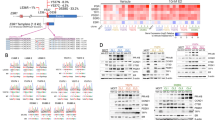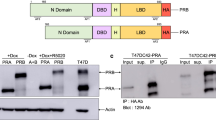Abstract
We have cloned and characterized a 77-kDa oestrogen receptor (ER) from an oestrogen-independent subclone of the MCF-7 human breast cancer cell line. This receptor contains an in-frame, tandem duplication of exons 6 and 7, located in the steroid-binding domain of the ER. This mutation has abrogated ligand binding, but not DNA binding, in this mutant ER. We previously described the partial structure of a unique oestrogen receptor (ER) that is expressed in an oestrogen-independent MCF-7:2A subclone of the breast cancer cell line MCF-7 (Pink JJ, Wu SQ, Wolf DM, Bilimoria MM, Jordan VC 1996a, Nucleic Acids Res 24 962-969). Sequence analyses determined the molecular weight of this 80-kDa ER to be 77 kDa, and hereafter this protein will be designated as ER77. Examination of the entire coding sequence of the ER77 mRNA indicates that it contains a tandem duplication of exons 6 and 7. Using a coupled transcription/translation system, a 77-kDa ER, which corresponds to the protein observed in the MCF-7:2A cells, was expressed. The ER77 protein does not bind the ligands [3H] oestradiol or [3H]tamoxifen aziridine. In DNA binding gel shift assays, the in vitro synthesized ER77 binds to a consensus vitellogenin A2 oestrogen-response element. In transient transfection experiments, the mutant ER, alone or in combination with the wild-type ER, does not induce expression of an oestrogen-responsive luciferase reporter construct. In fact, expression of the ER77 in the ER-positive T47D:A18 cell line inhibits E2-induced luciferase expression. Overexpression of wild-type ER in T47D:A18 cells leads to elevated constitutive expression of the luciferase reporter, which was inhibited by co-transfection with ER77. These data suggest that the ER77 can interfere with normal ER activity and does not act as a constitutive activator of oestrogen-independent growth in MCF-7:2A cells. Consequently, the constitutive growth observed in MCF-7:2A cells is probably the result of other ER-mediated pathways.
This is a preview of subscription content, access via your institution
Access options
Subscribe to this journal
Receive 24 print issues and online access
$259.00 per year
only $10.79 per issue
Buy this article
- Purchase on Springer Link
- Instant access to full article PDF
Prices may be subject to local taxes which are calculated during checkout
Similar content being viewed by others
Author information
Authors and Affiliations
Rights and permissions
About this article
Cite this article
Pink, J., Fritsch, M., Bilimoria, M. et al. Cloning and characterization of a 77-kDa oestrogen receptor isolated from a human breast cancer cell line. Br J Cancer 75, 17–27 (1997). https://doi.org/10.1038/bjc.1997.4
Issue Date:
DOI: https://doi.org/10.1038/bjc.1997.4



